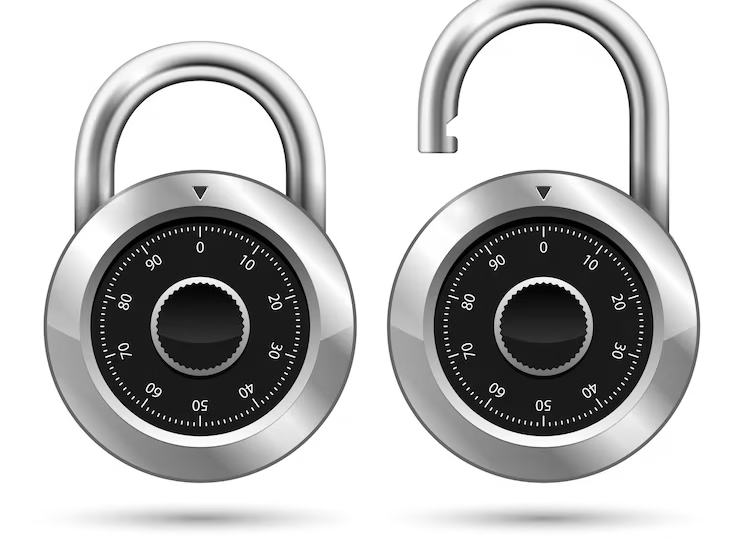Combination locks are popular for securing various items, from lockers and safes to doors and gates. With their simple yet effective design, combination locks offer convenience and security without needing keys. Let’s explore the key factors to consider when choosing the right combination lock for your needs, whether for home, school, or business use.
What are Combination Locks?
Combination locks require users to enter a specific sequence of numbers or symbols to unlock them. The correct combination activates internal mechanisms within the lock, allowing it to be opened. These locks are versatile and can be configured with different combinations, making them suitable for various applications. They are commonly used for securing lockers, safes, bicycles, gates, and even door locks, providing a reliable security solution without needing keys.
Combination locks balance convenience and security, making them popular for various security needs. Whether you need to secure a gym locker, office filing cabinet, or home safe, a combination lock provides a keyless solution tailored to your security requirements.
Types of Combination Locks
Several types of combination locks are available, each with unique features and advantages.
1. Traditional Combination Locks
- Operation: Require users to rotate dials or wheels to correctly align specific numbers or symbols.
- Simplicity: Simple to use and understand.
- Reliability: Offer reliable security for everyday applications.
- Durability: Known for their mechanical simplicity, which contributes to their durability.
- Resistance to Manipulation: Resistant to electronic manipulation.
- Ideal Uses: Preferred for general security needs where electronic interference is a concern.
2. Digital Combination Locks
-
- Operation: Feature electronic keypads or touchscreens for entering the combination.
- Complexity: Allow for more complex combinations.
-
Additional Features:
- Multiple user codes
- Audit trails
- Remote access capabilities
- Security: Provide advanced security features.
- User Interface: Offer user-friendly interfaces.
- Ideal Uses: Ideal for environments with high security and user management priorities.
Factors to Consider
When choosing a combination lock, several factors must be considered to ensure it meets your needs.
- Security Level: For high-security applications, choose a lock with robust construction, anti-tamper features, and a secure locking mechanism.
- Ease of Use and Accessibility: Consider how easy the lock is to use. Traditional locks are simple and reliable, while digital locks offer added convenience and advanced features.
- User Preferences and Needs: Ensure the lock meets the usability requirements of the users who will interact with it daily. Choose the type of lock that aligns best with their preferences and needs.
Installation and Maintenance
Consider the installation requirements and compatibility of the combination lock with the intended application. Some locks may require professional installation, especially for complex digital systems. Ensure the lock is compatible with the door or surface on which it will be mounted and that any necessary mounting hardware is included. Furthermore, the maintenance requirements of the combination lock should be considered. Traditional mechanical locks may require occasional lubrication and adjustment to ensure smooth operation, while digital locks may require battery replacement or software updates. Choose a lock that is easy to maintain and service to ensure long-term reliability and security for your property.
Advantages and Disadvantages of Combination Locks
Advantages of Combination Locks
- Keyless Convenience: One of the most significant advantages of combination locks is the elimination of keys. Without the need to carry a key, users avoid the risk of losing or misplacing them, which can be a major inconvenience and security risk.
- Customisable Security: Combination locks allow users to change the access code as needed. This is particularly useful in shared environments such as gyms, schools, or offices, where access codes can be regularly updated to maintain security.
- Durability: Mechanical combination locks are known for their robustness and longevity. They can withstand harsh weather conditions, making them suitable for outdoor use, such as securing gates or sheds.
Disadvantages of Combination Locks
- Forgetting Combinations: A common drawback is the possibility of forgetting the combination. Unlike a key that can be kept in a designated place, a combination must be remembered. If forgotten, it can be difficult to reset or retrieve without professional assistance, particularly with mechanical locks.
- Vulnerability to Tampering: While combination locks provide good security, they are not impervious to tampering. Skilled intruders might manipulate mechanical combination locks or hack digital ones if they are not equipped with advanced anti-tamper features.
- Maintenance: Digital combination locks require regular battery changes and may need software updates to ensure they function correctly. Though more durable, mechanical locks require periodic lubrication and adjustment to operate smoothly.
Conclusion
Choosing the right combination lock involves considering factors such as security level, type of lock, ease of use, installation requirements, and maintenance needs. By understanding these key considerations and evaluating your specific requirements, you can select a combination lock that balances security, convenience, and reliability. Whether for securing a locker at the gym, a door lock at home, or valuables in a safe, the right combination lock offers peace of mind and protection for your belongings.




RobertCAw 16 Jun 2025
¡Saludos, entusiastas de las emociones !
Casinos sin licencia en EspaГ±a con promociones activas – https://casinossinlicenciaenespana.es/ casinossinlicenciaenespana.es
¡Que vivas triunfos extraordinarios !
RobertFrava 16 Jun 2025
¡Hola, seguidores del entretenimiento !
Casinos extranjeros que permiten jugar sin identificaciГіn – https://www.casinoextranjerosespana.es/# mejores casinos online extranjeros
¡Que disfrutes de asombrosas tiradas exitosas !